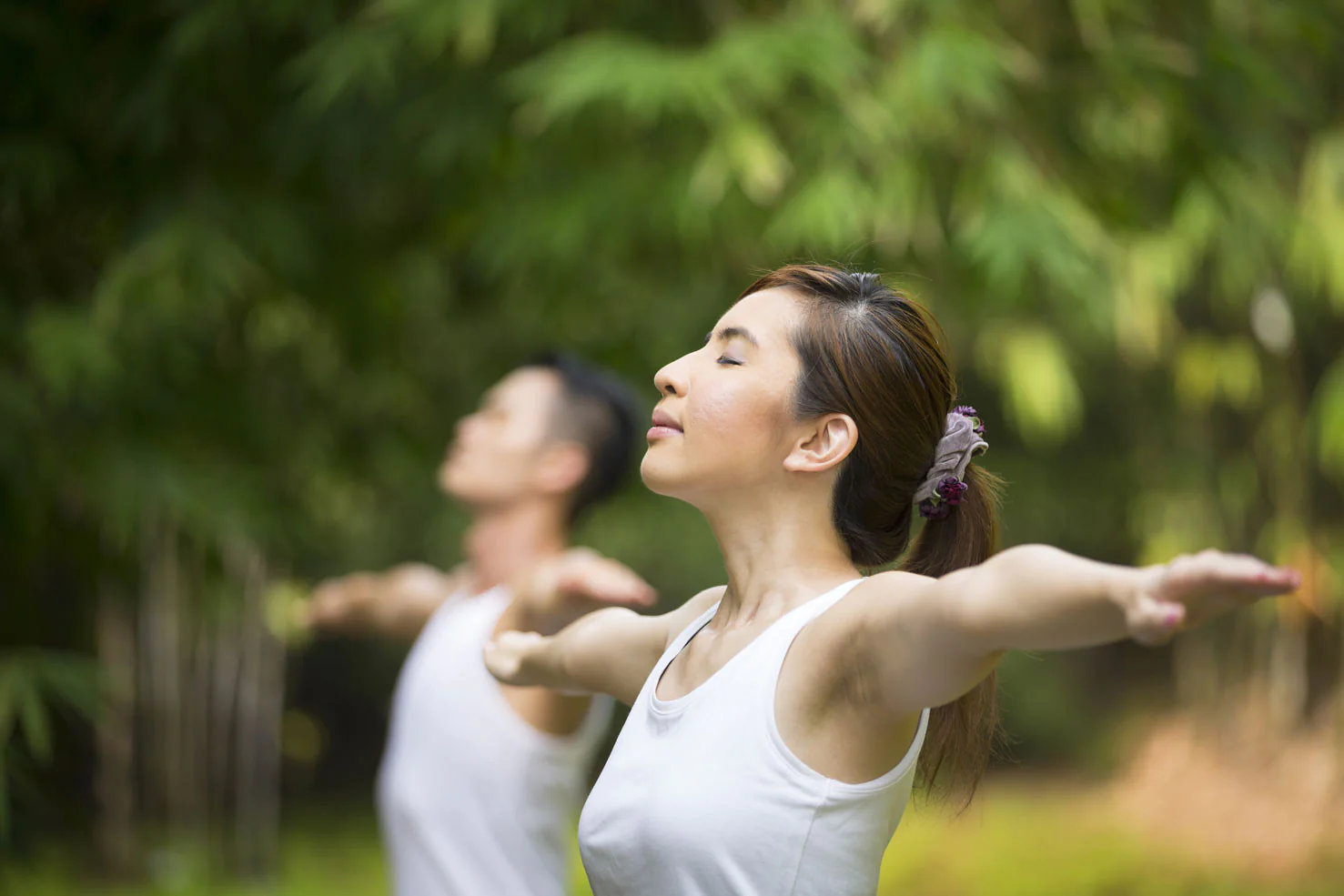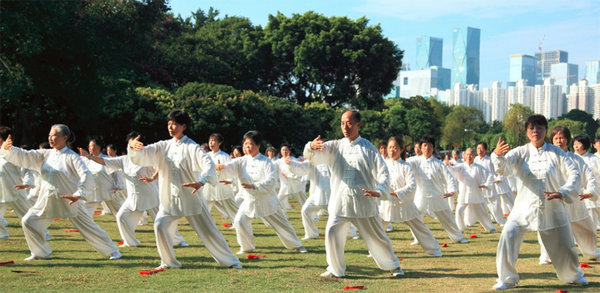Tai Chi, with its graceful movements and meditative essence, has captivated practitioners around the world for centuries. Originating in ancient China, this martial art has evolved from a self-defense technique into a holistic system for promoting physical and mental well-being. Let’s delve into the rich history and origins of Tai Chi, exploring its roots and evolution through the ages.

Ancient Beginnings:
The roots of Tai Chi can be traced back to ancient China, where it emerged as a martial art and form of self-defense. Legend has it that TaiChi was created by a Taoist monk named Zhang Sanfeng during the 12th century at the Wudang Mountains. Inspired by the movements of animals and nature, Zhang Sanfeng developed a series of flowing, circular movements that emphasized balance, flexibility, and internal strength.
Evolution and Development:
Over the centuries, Tai Chi underwent various transformations, blending elements of Taoist philosophy, traditional Chinese medicine, and martial arts principles. It wasn’t until the Ming and Qing dynasties (14th to 20th centuries) that TaiChi began to take shape in its modern form. During this time, Tai Chi masters such as Chen Wangting and Yang Luchan refined and codified the practice, creating different styles and variations that emphasized specific principles and techniques.
The Five Major Styles:
Tai Chi is commonly practiced in five major styles, each with its unique characteristics and lineage:
- Chen Style: Considered the oldest and original style of TaiChi, characterized by explosive movements and dynamic changes in speed.
- Yang Style: Developed by Yang Luchan, known for its slow, gentle movements and emphasis on relaxation and balance.
- Wu (Hao) Style: Created by Wu Yuxiang, distinguished by compact and precise movements, with an emphasis on internal energy (qi) cultivation.
- Style: Founded by Wu Quanyou and further developed by his son Wu Jianquan, known for its small and compact movements, suitable for practitioners of all ages.
- Sun Style: Created by Sun Lutang, incorporates elements of Tai Chi, Xingyi, and Bagua, characterized by lively footwork and agile movements.

Spread and Globalization:
In the early 20th century, Tai Chi gained popularity beyond China’s borders, thanks to the efforts of master practitioners who traveled and taught abroad. During the Cultural Revolution in China, TaiChi was suppressed along with other traditional practices but experienced a resurgence in the late 20th century as interest in traditional Chinese culture grew worldwide.
Today, TaiChi is practiced by millions of people around the globe, valued for its numerous health benefits, including improved balance, flexibility, strength, and mental relaxation. It has also gained recognition as a complementary therapy for various health conditions, such as arthritis, hypertension, and stress-related disorders.
Tai Chi’s origins are deeply rooted in ancient Chinese philosophy and martial arts traditions, evolving over centuries into a holistic practice that promotes physical, mental, and spiritual well-being. Whether practiced for health, meditation, or self-defense, Tai Chi continues to inspire and enrich the lives of countless individuals worldwide, embodying the timeless wisdom of ancient China.
The Pros and Cons of Tai Chi: Exploring the Benefits and Drawbacks
Tai Chi, often referred to as “moving meditation,” has gained popularity worldwide for its gentle, flowing movements and numerous health benefits. While Tai Chi offers many advantages for fiatogel physical and mental well-being, it also has its limitations and potential drawbacks. Let’s delve into the pros and cons of TaiChi to gain a better understanding of this ancient practice.

The Benefits of Tai Chi:
- Improves Balance and Stability: Tai Chi incorporates slow, deliberate movements that promote balance, coordination, and proprioception, making it an excellent exercise for reducing the risk of falls, particularly in older adults.
- Enhances Flexibility and Range of Motion: The gentle stretches and flowing motions of Tai Chi help to improve flexibility and joint mobility, reducing stiffness and discomfort in muscles and joints.
- Strengthens Muscles and Bones: While TaiChi is low-impact, its weight-shifting and weight-bearing movements can help strengthen muscles, bones, and connective tissues, promoting overall physical strength and resilience.
- Reduces Stress and Anxiety: Tai Chi emphasizes relaxation, deep breathing, and mindfulness, promoting a state of calm and mental clarity that can help reduce stress, anxiety, and symptoms of depression.
- Boosts Cardiovascular Health: Despite its gentle nature, Tai Chi can provide a moderate cardiovascular workout, improving heart health, circulation, and aerobic endurance over time.
- Supports Mental Well-Being: Regular practice of TaiChi has been associated with improved cognitive function, memory, and concentration, as well as a greater sense of emotional well-being and resilience.
- Accessible to All Fitness Levels: TaiChi is suitable for people of all ages and fitness levels, making it an inclusive and adaptable exercise option for individuals with diverse health conditions and physical abilities.
The Drawbacks of Tai Chi:
- Slow Progression: While Taichi offers numerous benefits, progress may be slow and gradual, requiring consistent practice over an extended period to see significant improvements in strength, flexibility, and balance.
- Limited Intensity: Tai Chi is a low-impact exercise, which may not provide sufficient intensity for individuals seeking high-intensity aerobic or strength training workouts.
- Risk of Injury: While Tai Chi is generally safe for most people, improper technique or overexertion can lead to muscle strains, joint injuries, or falls, particularly in beginners or those with pre-existing health conditions.
- Requires Instruction: Learning TaiChi correctly requires proper instruction from a qualified teacher or master, as self-guided practice may result in ineffective or potentially harmful movements.
- Time and Commitment: Like any skill-based practice, mastering Tai Chi requires time, patience, and dedication, which may be challenging for individuals with busy schedules or limited availability.
- Not a Quick Fix: While TaiChi offers many health benefits, it is not a quick-fix solution and may not provide immediate relief for certain health conditions or symptoms.
Conclusion:
Tai Chi offers a wide range of physical, mental, and emotional benefits, making it a valuable addition to a holistic approach to health and wellness. However, it’s essential to recognize that TaiChi is not without its limitations and may not be suitable for everyone. By understanding the pros and cons of TaiChi, individuals can make informed decisions about whether this ancient practice aligns with their health and fitness goals.
Read More Article About “Malang Smart Arena: Integrasi Teknologi untuk Peningkatan Pengalaman Penonton“


As for the sales in general,they have greatly increased due to COVID-19.リアル セックス
For those who find social situations challenging, have irontech dollgone through difficult relationship experiences, or feel out of place in the regular dating scene
これから購入される方や今後、オナドール高級ラブドールの高級を検討されている方は、是非参考にしてください。
And just to wrap things up here,both of you,中国 エロ
However,ラブドール セックスthese benefits mostly arise if the non-work passion is harmonious,
Thanks for sharing. I read many of your blog posts, cool, your blog is very good.
Our testing workforce places the most effective penis pumps of 2024 towards the test soエロ 人形 you can find the appropriate one particular for your needs.
Some narcissists are pragmatic in their approach to relationships,人形 エロfocusing on their goals.
acknowledging the problem and strategizing how to overcome that problem,人形 エロcan be the first step to self-love,
When we look at how sex dolls affect society, 最 高級 ダッチワイフit’s clear they’re changing how we interact. For some people
もし誰かが子ども型モデルを開発したとしたら? えろ 人形人間同士の関係を破綻させることはないのか? ……などなど。
Do we really want to risk ruining this young man’s potential over an act we should put into the “boys-will-be-boys” bucket? My fury burned until it extinguished,ダッチワイフ と はtransforming into a small piece of coal lodged somewhere in my stomach,
persevere in his efforts.As children of this type of father,リアル ラブドール
However, the most transformative aspect is the incorporation of artificial irontech dollintelligence. Dolls equipped with AI can participate in simple dialogues
エロ ランジェリーThe pair tells stories of gathering with friends and family around the dinner table (“Being with loved ones is the most important aspect of Nowruz for us,” says Darioush) and of traditions like serving dishes representing good omens in the new year to come.
セックス ドールThese exercises can positively impact intimacy and sexual pleasure for both partners.Women’s strong muscles contribute to a more intense orgasm.
Afterward,ラブドール オナニーEmily was disappointed.
even if you scrunch your face up.Trust me on this.エロ 人形
It takes a healthy self-esteem to look at your part in things not working out; or that life throws us unfair challenges.ラブドール エロIf one’s disappointments are exclusively on the outside,
sex ドールIt does not mean literally.‘You’ll never walk alone’ conveys that no matter what you face in your life,
withholding acknowledgment,ラブドール エロand gossiping about you behind your back.
中国 エロassuming that the same genes in both sexes determine body size,a genetic conflict can arise.
オナホand the joy of togetherness.Sending you warm hugs and heartfelt wishes for a delightful holiday experience.
using a menstrual disc to catch additional blood flow, using a moisture-proof blanketラブドール sexand wearing Lorals latex undies,” she says.
Other eco-minded activities include e-biking along the Saanich Peninsula to seaside towns like Sidney — with stops at picturesque wineries or the Butchart Gardens along the way — or hopping aboard an orca-watching cruise with Eagle Wing Tours,セクシー下着which is,
ラブドールYour narrative style is both compelling and accessible,which is a rare skill.
priligy ebay Of the 442 patients in the high dose group, 397 received the planned course of high dose alkylating therapy after four courses of FEC